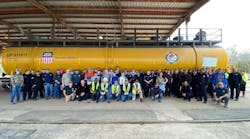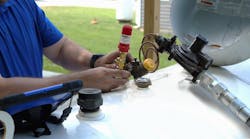Using the right sealing materials in chemical transportation valve applications enables the safe and effective movement of chemicals, reducing the risk of non-accidental releases (NARs). It also minimizes the need for valve changeouts, which significantly reduces the total cost of ownership for a carrier or shipper. It avoids lost time involved in bringing equipment into a maintenance shop and waiting for an inspector to sign off on completed work, and it reduces labor costs for the maintenance itself.
Stakeholders can ensure the right seal material is used for their shipments by consulting a seal manufacturer experienced in performing chemical compatibility testing, material testing, and root cause failure analysis (RCFA). While chemical compatibility and material testing is performed upfront to ensure the best sealing solution is chosen, RCFA is conducted after a failure has occurred, to identify the cause of the failure and assist in developing an improved solution to prevent future failures.
This article discusses the various test methods and how partnering with an experienced seal supplier can help chemical shippers and transporters minimize the risk of NARs and reduce costs associated with equipment maintenance.
Chemical compatibility
Many valve original equipment manufacturers (OEMs) rely on generic information or data sheets to select seals for their equipment. However, the critical nature of chemical cargoes demands a more thorough understanding of the chemical makeup of both the commodity being carried and the seal material, to predict the interaction between the two when they come in contact with one another. It is important to seek guidance from sealing experts who can help recommend the right material for a valve application and the chemical being hauled.
Seal manufacturers that perform extensive material testing can provide the best recommendations for chemical compatibility. They typically begin by testing the chemical compatibility of the commodity and the seal material used to secure the valve. Experienced seal manufacturers, like Trelleborg, can provide detailed application reports that give numerical data, such as hardness and volume change, for a variety of seal materials—their own and competitive materials—based on the chemicals with which they come in contact. The data provided often shows the differences between formulations as their performance can vary greatly.
This process ultimately saves valuable time and money by demonstrating how sealing materials react with specific fluids before the seals are installed in the equipment. This is especially important for challenging applications in which the seal must interact with a wide range of chemicals that are sometimes found in aggressive mixtures.
Material testing
Reliable seal manufacturers offer various ASTM and ISO physical testing capabilities to measure hardness, density, tensile strength, elongation, and volume change. They also conduct material composition and temperature testing, including thermalgravimetric analysis (TGA), Fourier transform infrared spectroscopy (FTIR), differential scanning calorimetry (DSC), and TR-10 testing, reviewing each report with the customer to interpret the data.
Well-equipped seal manufacturers utilize advanced instrumentation, such as a scanning electron microscope and FTIR, that analyze material changes caused by interaction with the contact fluid. Computer simulation of these material changes is a valuable tool that predicts performance and enables users to switch seal materials if needed before an unsuitable material is deployed in the field.
Other assessments include testing to a specification, long-term property tests to observe how a seal material changes over time, and immersion testing. During immersion testing, ASTM International and ISO standards are followed, with materials submerged in liquid at a certain temperature to test for changes in the material performance.
Material testing must be completed according to internationally recognized safety standards or the seal supplier’s internal parameters if no recognized standards exist. The seal supplier may also consult safety data sheets to determine if the commodities to be tested contain hazardous chemicals that do not meet health and safety requirements for internal testing at its facility. This information is extremely important to seal manufacturers when determining whether to conduct testing in-house or to use a specially qualified third-party testing laboratory. Regardless of where the testing is conducted, the laboratory should have ISO 17025 accreditation with up-to-date external auditing documentation.
Driving the market
When new chemicals enter the market, they have the potential to drive market trends. For example, OEMs today are looking for materials that can withstand high pressures and low temperatures, such as those present with hydrogen fueling. As the focus on sustainability and electrification increases, it is likely that a variety of new commodities will enter the market. At times like these, when a seal manufacturer does not have an existing solution for a new commodity that is being transported, it is important that the OEM and seal manufacturer work together to create one. The development of a solution often requires multiple iterations and extensive testing. Finite element analysis (FEA) can help expedite the process.
FEA enables OEMs and seal suppliers to predict the performance of valves and seals when exposed to various chemicals for applications that are difficult to replicate in a laboratory. To ensure success, it is extremely beneficial to have engineering and material testing teams working jointly in a highly advanced materials test laboratory capable of finding the linear and nonlinear material properties required for FEA. The sealing experts should review all paperwork after performing tests and conduct proficiency testing with a third-party provider to ensure results. As a last step, the seal manufacturer compiles all results and compares them with those published by other labs. This helps establish the credibility of the results and builds trust with the valve OEMs.
Root-cause analysis
While chemical compatibility and material testing is conducted proactively to help minimize the risk of seal failures, failures do sometimes occur. When that happens, it is important that OEMs, cargo tank owners, and shippers be able to rely on their sealing partners to conduct RCFA testing to understand the cause of the breakdown and assist in preventing future failures. This is especially important since seal failures can cause NARs, possibly resulting in catastrophic environmental disasters and significant fines. Some seal manufacturers provide critical RCFA support free of charge to give customers a one-stop shop for their sealing needs.
The right partner
Each situation and failure is unique. Therefore, it is important to have a sealing partner with years of experience and a wide range of resources to best identify the root cause of a failure and develop solutions to prevent future recurrences. Identifying the root cause of a failure can be challenging because it is often not limited to a single issue, but a combination of factors. Different failure modes can look similar requiring the sealing expert to make an educated analysis based on the available information. And by the time a seal arrives at the manufacturer for analysis, it may be so degraded that it is unidentifiable. Other challenges include having limited information, for example not knowing the lubrication that was used with the seal.
When selecting a sealing partner, OEMs, shippers, and carriers should not only investigate the seal manufacturer but also ask if the sealing partner works with third-party laboratories for hazardous material exposure and if they invest in quality equipment and personnel. Ultimately, the choice of sealing partner can mean the difference between safety and peace of mind, and environmental disasters and sleepless nights. So, it is important to choose wisely.
Time is money
While safety is paramount, the cost associated with selecting the best sealing solution also is important. The proper sealing material for a commodity lasts longer than a poorly suited material, which can greatly reduce the need for seal replacements and increase the equipment’s time in use. For equipment that is used to haul varying commodities from trip to trip, it is extremely important to select a material with a wide operating range. This will reduce the need to pull equipment out of operation and into a maintenance shop to replace the sealing components. An experienced sealing partner with a wide range of high-performance materials is most likely to be able to recommend and offer the material best suited to the user’s needs.
Conclusion
Chemical compatibility testing, material testing, and RCFA all work together to ensure that carriers, shippers and OEMs select the right seals for their chemical transportation applications. When chemical compatibility and material testing is thorough, it can help prevent NARs, as well as save companies time and money. And when a failure does occur, RCFA helps users identify the source of the problem and provides peace of mind that the issue is resolved sufficiently to minimize the opportunity of a recurrence.









